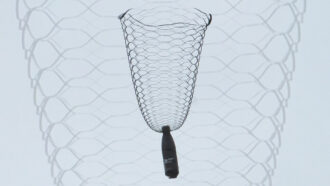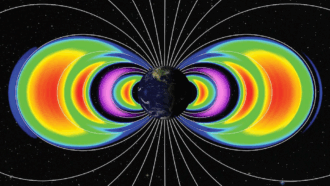New waves for safe flying
Scientists are perfecting a new generation of airport scanning machines.
Share this:
- Share via email (Opens in new window) Email
- Click to share on Facebook (Opens in new window) Facebook
- Click to share on X (Opens in new window) X
- Click to share on Pinterest (Opens in new window) Pinterest
- Click to share on Reddit (Opens in new window) Reddit
- Share to Google Classroom (Opens in new window) Google Classroom
- Click to print (Opens in new window) Print
By Emily Sohn
On December 21, 1988, hundreds of passengers boarded Pan Am flight 103 at Heathrow Airport in London. Travelers included families, musicians, businessmen, hair stylists, teachers and dozens of college students flying home for the holidays. Their destination was New York City.
The flight took off around 6:30 pm, just a little behind schedule. About half an hour later, a bomb exploded onboard. The plane broke apart. Chunks of metal showered a small Scottish town called Lockerbie. The accident, now known as the Lockerbie Bombing, killed all 243 passengers, all 16 crewmembers, and 11 people on the ground.
It wasn’t the first attack on an airplane, and it certainly wasn’t the last. Perhaps the worst, and most famous, attack happened on September 11, 2001. That day, terrorists flew two airplanes into skyscrapers in New York City. Nearly 3,000 people died.
But Pan Am flight 103 also stands out because it was one of the first times that terrorists carried out a major attack on a non-military airplane. The bombing also started a new era in science, says Doug McMakin, an electrical engineer at the Pacific Northwest National Laboratory in Richland, Wash. Suddenly, airport security was a big deal.
“It kicked up research dollars on explosive detection technologies,” McMakin says. “This is one way [terrorists] try to put fear in us — by blowing up airplanes. What we’re trying to do is counter that threat.”
In the race to stay one step ahead of terrorists, researchers are working on a new generation of machines that can peer through fabric and see what people are carrying inside their clothes. Some airports are already starting to use these devices, called scanners.
Even as technology makes skies safer, however, worries have popped up. Some people wonder if airport scanners will threaten their privacy by showing every curve of their bodies and what’s in their pockets. People also worry about how the machines might affect their health.
Experts are doing their best to assure people that the new equipment is safe. More than that, it’s necessary. Our lives, they say, depend on it.
The long wait
If you’ve ever been on an airplane, you know the drill. After arriving at the airport, you wait in one snaking line to check in your luggage. Then you move to an even longer line, where you wait to get into the main terminal.
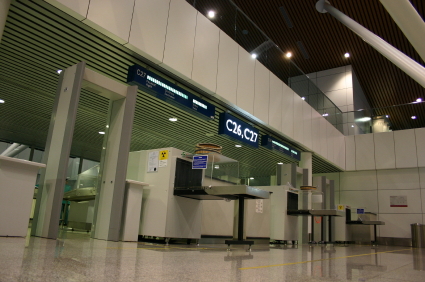 |
|
Security gates are a staple of modern airline travel. New work would add new detail to security screening.
|
| fenlan1976/iStockphoto |
After throwing away your water bottle, you show your I.D. and boarding pass to an official. You take off your jacket, belt and shoes. You put them on a conveyor belt, along with your carry-on bag. As X-rays zap your belongings, you walk through a doorframe that has no door. If it beeps, you start over.
As annoying as the whole process may seem, each step is designed to keep travelers safe. And behind the scenes, a whole lot of technology — and history — is involved.
When everyday people started traveling by air in the 1930s, they simply walked into the airport and onto their planes. In response to hijacking threats in the 1960s and 1970s, American airports began to require that passengers and their bags be screened. Airports added metal detectors to prevent weapons and explosives from getting onto planes.
Since then, airport security agencies have been pursuing the latest technologies. Every time an attack happens, new security rules follow. In December 2001, for example, the “shoe bomber” boarded a plane with explosives hidden in the soles of his shoes. After that, airports started to require that passengers send their shoes through X-ray machines.
A spectrum of strategies
Among the security technologies you may have already seen at airports are chemical-detecting swabs, explosive-detecting puffer machines, even drug-sniffing dogs.
Coming next are full-body scanners that look through clothes to detect what people might be trying to sneak through the gate. Two types of scanning technologies are in the works. One is called a backscatter machine. The other is a millimeter-wave system.
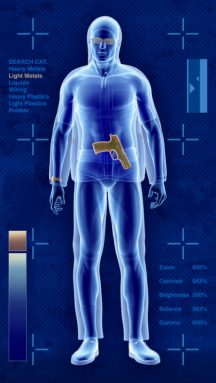 |
|
This illustration gives the general idea: New scanners in the works would quickly reveal what’s in your pockets.
|
| cirnishman/iStockphoto |
Both are already starting to appear in airports around the world. Still, experts continue to debate which one is better.
Behind both machines is the same science: the electromagnetic spectrum. The spectrum describes a range of energy forms, which travel and behave as waves. At one end of the spectrum are low-energy radio waves and microwaves. At the other end are high-energy gamma rays, X-rays and ultraviolet radiation. Visible light — what we can see — lies somewhere in the middle.
A millimeter-wave imaging scanner looks like a round phone booth. It uses a part of the electromagnetic spectrum called millimeter waves. These waves lie just to the right of microwaves, which means they carry a little more energy than microwaves do. But they have less energy than infrared waves.
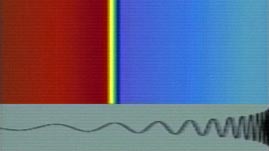 |
|
Millimeter-wave machines would scan passengers using a part of the electromagnetic spectrum (illustrated) that sits between microwaves and infrared. See the full video.
|
| NASA, Teachers’ Domain |
When a person steps inside a millimeter-wave imaging scanner, two 7-foot long beams of millimeter waves scan his body from head to toe. These waves pass through fabric, but they bounce off the water in our skin and in liquids that people might be trying to sneak onboard. (Some explosives start out as liquids). Millimeter waves also ping off plastic, paper, ceramics, even little nuggets of gum.
A computer inside the scanner detects the reflections and turns them into a three-dimensional image that pops up on a screen. The picture shows the outline of a passenger’s figure and everything he’s carrying under his clothes or in his pockets. Workers survey the image for suspicious objects.
“They’re going to detect threats that metal detectors don’t get,” says McMakin, who researches millimeter-wave machines. “The eyes will go to things that shouldn’t be there.”
The system is quick, and getting quicker. With modern computers, McMakin says, a scan takes about a second and a half. A visible image shows up just two or three seconds after that. As computers get even faster and cheaper, the equipment is becoming increasingly practical.
Millimeter-wave technology is also safe. It uses 10,000 times less power than a cell phone does. And millimeter waves have too little energy to harm human health.
Backscatter
In a sort of technological face-off, millimeter-wave scanners are going head-to-head with backscatter scanners. Instead of using millimeter waves, backscatter devices employ X-rays. These are the same waves that machines at hospitals use to penetrate flesh and look for broken bones.
Because they use the higher-energy X-rays, backscatter scanners produce images that are more detailed than millimeter-wave machines spit out. Some people think the images are clearer and make unusual objects easier to identify.
For now, backscatter scanners are a little slower than millimeter-wave scanners, McMakin says. The technology has also raised some health concerns. X-rays produce a type of radiation that can, in some cases, damage human cells and cause cancer.
Despite the rumors, however, even backscatter machines are safe, says medical physicist James Hevezi, chair of the American College of Radiation Medical Physics Commission. One scan, he says, delivers the same amount of radiation as spending two minutes in an airplane at 30,000 feet.
In other words, the machines are far safer than flying is.
“It really is not a health concern,” Hevezi says. “It is a much lower dose than anything used in medicine.”
Perhaps a bigger concern is privacy, and that applies to both systems. In addition to showing slips of paper in pockets and explosives in underwear, scanners reveal every curve of a passenger’s body.
Some day, computers might be able to read the scans on their own without the help of human eyes, making this worry irrelevant. In the meantime, Hevezi, says, people will have to compare the benefits of scanning technology with the potential risks of flying without its help.
“The benefit is safety in the air when we travel,” he says. “If people want to travel in modes other than air travel, they can do it that way. Or they can ask to be patted down instead. There are still some choices we can make.”
Toward the horizon
As engineers continue to tinker on imaging technologies, their discoveries are fueling industries that have nothing to do with security. A company called Intellifit, for example, is using millimeter-wave scanners to help people buy jeans.
In less than 15 seconds, the machine spits out precise body measurements that can be used to design custom-made clothing. Scanners could also help dieters take body measurements to see whether they are getting slimmer. Scanners are already being used for these reasons in a few places.
As for security, advances in science should make air travel safer and safer, experts say.
“We’re just at the start of where we could go,” McMakin says, “and what it could be.”
TEACHER’S QUESTIONS
Here are questions related to this article.

